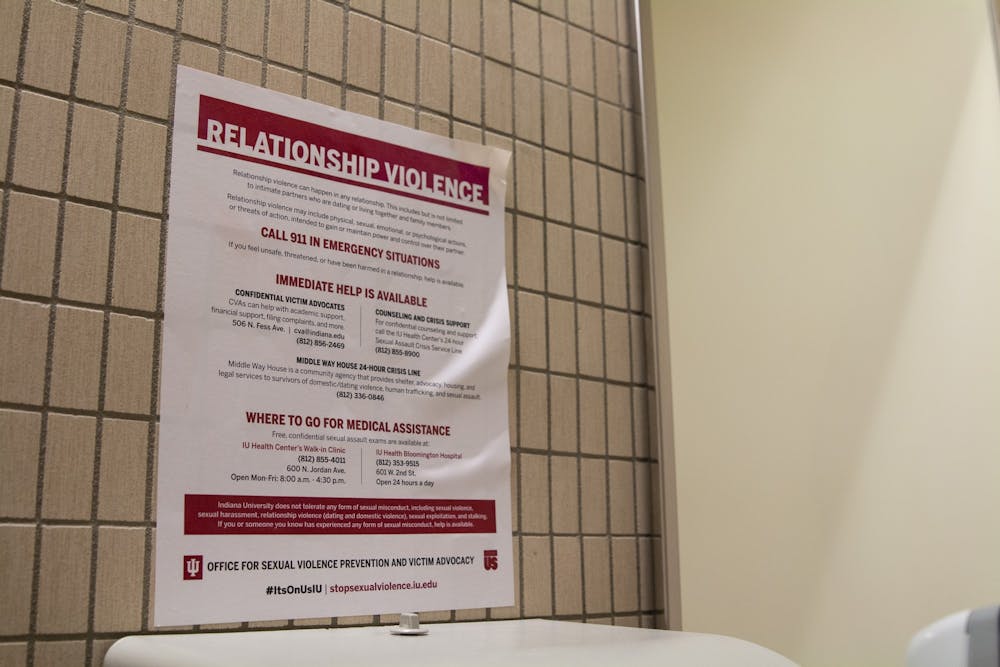IU released preliminary results of a survey measuring students’ attitudes about sexual misconduct the first week of December.
Half of IU-Bloomington students were selected last spring to participate in the 2019 Campus Climate Survey, and about 3,000 of them completed the survey. That’s about 7% of the total undergraduate and graduate student population.
The sample was meant to be proportional to the overall student population based on various traits such as gender and undergraduate or graduate student status. Springston said this data can be generalized to the IU student population, but some uncertainty is inevitable in all surveys.
So far, the results are just presented as “key findings.” The full report will be available in January, said Emily Springston, university Title IX coordinator and director of the Office of Institutional Equity. The preliminary results include statistics about attitudes on sexual misconduct being a problem, whether students feel safe and the processes of reporting and investigating sexual misconduct.
According to the Stop Sexual Violence website, 82% of participants thought sexual misconduct is a problem on campus, and 92% thought sexual misconduct is a problem throughout society.
The survey reports 81% of participants felt the university would take a report seriously, 72% felt the university would protect someone reporting from retaliation and 72% felt the university would ensure due process and a fair investigation.
Emma Norris, IU junior and Feminist Student Association outreach officer, has attended many rallies against sexual violence. She said the statistics about IU handling sexual misconduct surprised her, especially the last statistic. She thought the numbers would be lower.
“I don’t necessarily think IU has the best history of handling sexual assault cases quickly or fairly or painlessly,” Norris said.
She said she knows many people who have experienced sexual violence but haven’t taken any official or legal action. It could be because of the stigma surrounding sexual assault and the emotional toll the proceedings can take, she said.
Springston said one of the most important key findings from the survey is 74% of participants felt they could do something about sexual misconduct.
“To me, there’s no simple fix to this problem,” she said. “So that’s a really positive feedback that survey participants, and therefore students, are having a role in addressing this issue.”
Norris said she wanted more information on what “do something” means.
“Arguably, 100% of us can do something about sexual misconduct,” she said.
She also said many of IU’s initiatives for decreasing sexual misconduct exist in a hypothetical world. However, many people have already experienced sexual violence and need support after the incident.
“So much of the focus is on what happens before or what happens during, but not necessarily what happens after,” Norris said.
She said she went to CAPS for counseling after she experienced sexual violence, but she didn’t feel empathy or support from her counselor.
“Everything seems to work in a way that’s so methodical, so distant from any sense of actual humanity,” she said. “The people who come in and out are numbers. It’s all about working people through the system so they can say, ‘Oh, we did this, and we served this many people.’”
The Campus Climate Survey results come at a time when the Bloomington campus has had the most reports of sexual misconduct since the university began releasing Title IX reports in the 2014-15 school year.
Springston said the spike in reports isn’t necessarily a bad thing. Cases of sexual misconduct are happening, she said, so the increase in reports suggests students might be more educated and comfortable to report.
“It means these students are connected to resources, to options for how to report and to address it,” Springston said.
She said some of these resources include training and education for graduate students and the It’s On Us program for all first-year students.
Norris said the rise in reports suggests the stigma surrounding sexual violence is decreasing, especially in the wake of the #MeToo movement.
“I don’t think the number of assaults has gone up at all,” she said. “I think it’s because of the culture.”
Norris said sexual violence has been one of the most taboo topics in society.
“It’s uncomfortable, it’s graphic, it’s awful,” she said. “But fortunately, I think people feel more comfortable coming out and talking about their story, and feel more empowered to do something about what has happened to them.”
If people discuss sexual misconduct, there will be more awareness about how to behave appropriately, more accountability for people who don’t and more support for people who are victims of any type of sexual misconduct, Springston said.
“I don’t think this is an issue that’s going to turn itself and go away overnight, so one of our most important processes is to air it out, to let it be known to our community, to make sure we’re talking about it,” Springston said.




